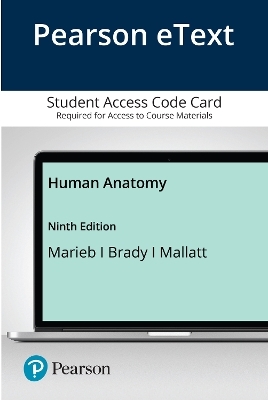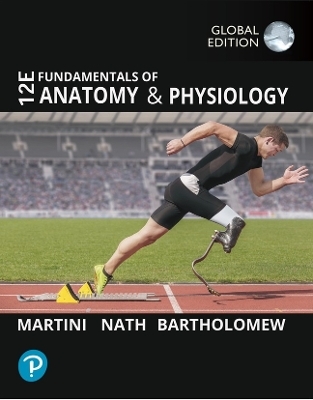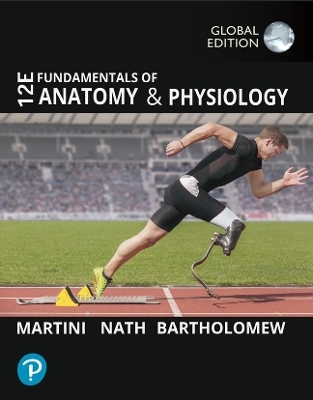
Human Anatomy
Pearson (Hersteller)
978-0-13-527301-2 (ISBN)
Human Anatomy tells a "story" of the human body, using illustrations, analogies, and comparative descriptions to help you visualize and master anatomical terms and functions.
For one-semester courses in human anatomy.
Pearson eText is an easy-to-use digital textbook that you can purchase on your own or instructors can assign for their course. The mobile app lets you keep on learning, no matter where your day takes you -- even offline. You can also add highlights, bookmarks, and notes in your Pearson eText to study how you like.
NOTE: This ISBN is for the Pearson eText access card. Pearson eText is a fully digital delivery of Pearson content. Before purchasing, check that you have the correct ISBN. To register for and use Pearson eText, you may also need a course invite link, which your instructor will provide. Follow the instructions provided on the access card to learn more.
About our authors Elaine N. Marieb received her Ph.D. in zoology from the University of Massachusetts at Amherst and joined the faculty of the Biological Science Division of Holyoke Community College. While teaching at Holyoke Community College, where many of her students were pursuing nursing degrees, she wanted to better understand the relationship between the scientific study of the human body and the clinical aspects of the nursing practice. To that end, while continuing to teach full time, Dr. Marieb pursued her nursing education, which culminated in a Master of Science degree with a clinical specialization in gerontology from the University of Massachusetts. It is this experience that has informed the development of the unique perspective and accessibility for which her textbooks and lab manuals are so well known. Dr.Marieb passed away in 2018 after a lifetime of supporting numerous institutions and programs. Perhaps her favorite cause was helping students, especially nontraditional students, pursue their goals in science. She gave generously to provide opportunities for them to further their education by, to name just one example, funding the E. N. Marieb Science Research Awards at Mount Holyoke College. She also believed strongly in research: she underwrote the renovation of the biology labs in Clapp Laboratory at Mount Holyoke College and provided funding for reconstruction and instrumentation of a cutting-edge cytology research laboratory at the University of Massachusetts at Amherst. Her legacy of contributing to science education lives on through the Elaine Nicpon Marieb Foundation, which provides support to multiple causes and organizations. In 2021, the Foundation provided a generous donation to University of Massachusetts, Amherst, which is now home to the Elaine Marieb College of Nursing. Dr. Marieb has also provided philanthropic support to Florida Gulf Coast University, which is home to the Elaine Nicpon Marieb College of Health and Human Services. Patricia M. Brady's interest in human anatomical form was sparked in college when she learned that the human skeleton could reveal an individual's age, sex, nutritional status, and even how many children a female had given birth to. She pursued this interest, earning a PhD from Brown University in biological and medical sciences. Dr. Brady has an extensive career as an undergraduate anatomy educator at Brown University, Rhode Island College, Community College of RI, and Johnson & Wales University. At the graduate level, Dr. Brady coordinates and teaches a clinically focused cadaver-based dissection course for the Johnson & Wales University Center for Physician Assistant Studies. Dr. Brady's commitment to teaching has been recognized throughout her career. In 1991 she received the Presidential Award for Excellence in Graduate Teaching from Brown University and in 2011 the Teaching Excellence Award from the Community College of Rhode Island. Dr. Brady embraces innovation in the classroom and laboratory, incorporating Project Based Learning, POGIL activities, cooperative team-based dissection and other active learning strategies into her courses. The driving factor behind these innovations is the desire to aid student learning by making course materials accessible and to make the study of anatomy an active and interactive process. Dr. Brady has shared her tools, techniques, experience, and enthusiasm for student success through professional presentations at national and regional meetings, including those of the Human Anatomy and Physiology Society (HAPS), the New England Biology Association of Two Year Colleges (NEBATYC), and Strategies to Success Conferences. In addition to teaching, Dr. Brady contributes to the development and use of multimedia course tools for human anatomy instruction, is a contributing author and reviewer for a number of anatomy and physiology publications, and is a reviewer for Anatomical Sciences Education. She is a member of Sigma Xi, the Human Anatomy and Physiology Society, the American Association of Anatomists (AAA), National Association of Biology Teachers (NABT), and the PULSE Community (Partnership for Undergraduate Life Science Education). Most mornings Dr. Brady can be found on the water rowing in an eight-oared shell or a single scull, pursuing another passion she developed in college. Jon Mallatt earned his Ph.D. in Anatomy from the University of Chicago. Dr. Mallatt is currently a Clinical Faculty of the University of Washington's WWAMI Medical Education Program at the University of Idaho. Previously Dr. Mallatt served as Associate Professor of Biological Sciences at Washington State University, where he taught human anatomy to undergraduates of all backgrounds for 37 years. WWAMI honored him with their "Excellence in Teaching Award" in 1992, 1993, 1995, and 2000, and 2017. Additionally Dr. Mallatt is an adjunct Associate Professor in the department of Biological Structure at the University of Washington. His particular areas of expertise are histology, human and comparative anatomy, and anatomical drawing, although his research now focuses on the origin and evolution of consciousness among animals. Dr. Mallatt is an accomplished researcher with 58 publications in a variety of fields ranging from vertebrate evolution to molecular phylogeny to neurobiology and consciousness studies.
Brief Contents
The Human Body: An Orientation
Cells: The Living Units
Basic Embryology
Tissues
The Integumentary System
Bones and Skeletal Tissues
Bones, Part 1: The Axial Skeleton
Bones, Part 2: The Appendicular Skeleton
Joints
Skeletal Muscle Tissue
Muscles of the Body
Fundamentals of the Nervous System and Nervous Tissue
The Central Nervous System
The Peripheral Nervous System
The Autonomic Nervous System and Visceral Sensory Neurons
The Special Senses
The Endocrine System
Blood
The Heart
Blood Vessels
The Lymphatic and Immune Systems
The Respiratory System
The Digestive System
The Urinary System
The Reproductive System
Answers Appendix: Answers to Check Your Understanding, Multiple Choice, and Matching Questions Appendix A: The Metric System
| Sprache | englisch |
|---|---|
| Themenwelt | Schulbuch / Wörterbuch |
| Studium ► 1. Studienabschnitt (Vorklinik) ► Anatomie / Neuroanatomie | |
| Studium ► 1. Studienabschnitt (Vorklinik) ► Physiologie | |
| Naturwissenschaften ► Biologie | |
| Sozialwissenschaften ► Pädagogik | |
| ISBN-10 | 0-13-527301-3 / 0135273013 |
| ISBN-13 | 978-0-13-527301-2 / 9780135273012 |
| Zustand | Neuware |
| Haben Sie eine Frage zum Produkt? |
aus dem Bereich

